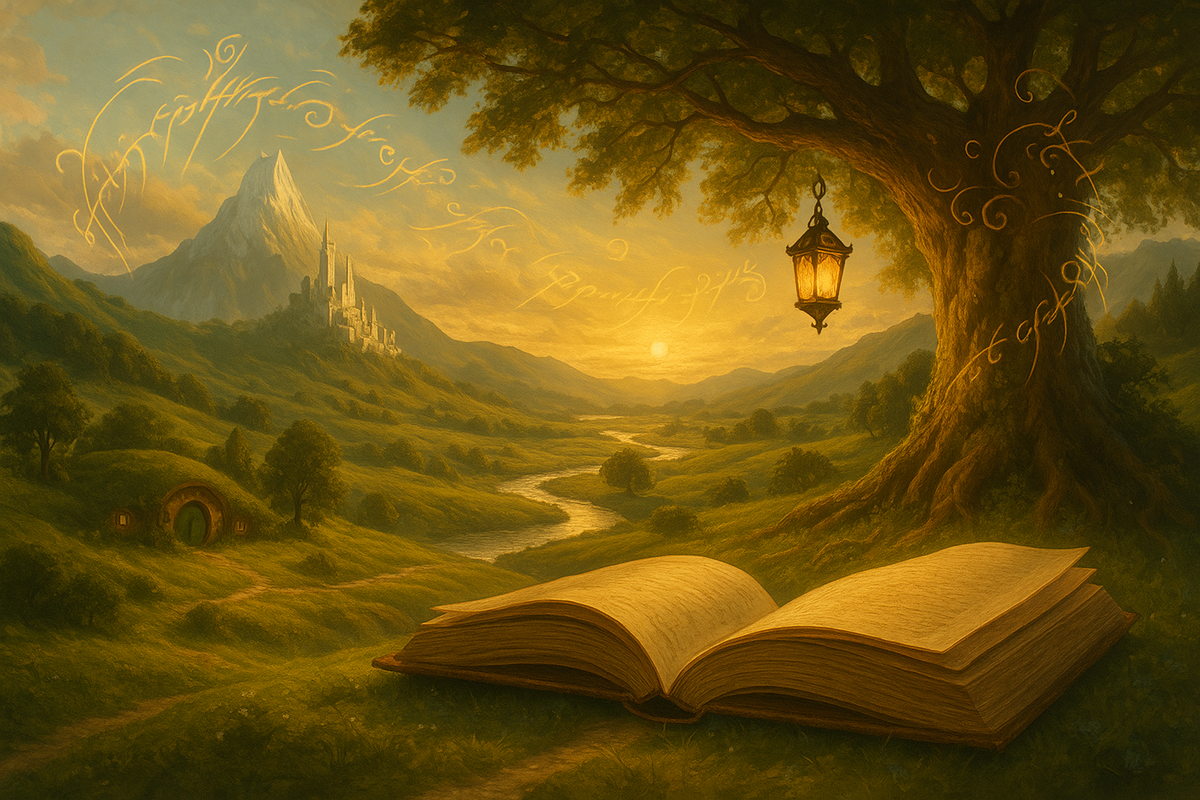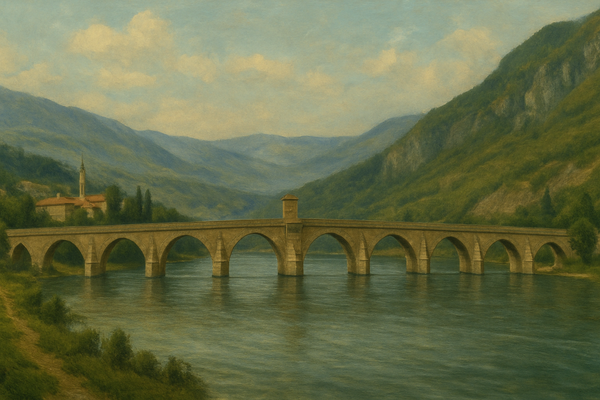🔴 Viewpoint: Tolkien's Legendarium - Lessons in Narrative, Lore, and Lifelong Re-reading
There exists a peculiar alchemy in the way certain literary worlds seize not just our attention, but our very soul—and Tolkien's Middle-earth has been, for me, such a transformative landscape.

There exists a peculiar alchemy in the way certain literary worlds seize not just our attention, but our very soul—and Tolkien's Middle-earth has been, for me, such a transformative landscape. The mythology he crafted resonates at frequencies that reach beyond mere storytelling, touching something primordial within me that recognises truth even in the guise of fantasy. His work represents not simply an escape from reality, but a deeper immersion into it—a mirror held up to our world that reveals its beauty, its terror, and its profound moral architecture. Through the lens of hobbits and wizards, of ancient trees and forgotten kingdoms, Tolkien offers a cartography of the human condition, mapping the eternal struggle between light and shadow that exists not just in distant, imagined realms, but within the chambers of my heart. The enduring power of his creation lies in this recognition: that in journeying through Middle-earth, I am simultaneously navigating the uncharted territories of my own existence.
For me, the gateway to J.R.R. Tolkien’s Middle-earth was not perhaps the conventional, gentle path through the Shire, but an unexpected plunge into the heart of conflict. Imagine an adolescent reader browsing a bookstore, finding only a single volume of The Lord of the Rings available: The Two Towers. I felt drawn to it somehow (perhaps the One Ring calling?), so I brought it home and thought I'd read just the beginning, though I wasn't sure if tracking down the other volumes would be difficult or not. The fact is, this serendipitous, somewhat disorienting introduction to Tolkien's magnum opus profoundly shaped my initial, and indeed, lifelong engagement with his work. The immediate immersion is into a world already fractured and in motion: Aragorn, Legolas, and Gimli in desperate pursuit of captured hobbits; Merry and Pippin escaping into the ancient, sentient Fangorn Forest; and Frodo Baggins and Samwise Gamgee on their grim, perilous trek towards the land of shadow, Mordor, with the treacherous Gollum as their guide! Long story short, I just couldn't put it down.
Honestly, the fragmented narrative structure of The Two Towers, with its distinct, interlaced storylines following separate groups of the sundered Fellowship, might initially seem bewildering. One part details the heroic efforts in Rohan and the battle for Helm's Deep, while the other follows the Ring-bearer's arduous journey. Yet, for a reader encountering this volume first, this very structure, lacking the full context of The Fellowship of the Ring, can paradoxically fuel a more intense curiosity. The absence of a clear beginning creates an urgent need to understand the antecedents of the epic events unfolding, the identities of the myriad characters, and the nature of the overarching conflict. This experience mirrors an in media res (in the middle of things) entry into a classical epic, compelling the reader to become an active investigator, piecing together the narrative from the clues embedded within the text. The themes of a stark struggle against an encroaching, pervasive darkness, the diverse forms of heroism displayed by individuals thrust into extraordinary circumstances, and the palpable sense of a deep, underlying history leave an indelible mark. The feeling of being dropped into a vast, ongoing conflict is both overwhelming and profoundly captivating, igniting a compelling desire to seek out the preceding and succeeding parts of the trilogy to grasp the entirety of the saga. This unusual entry point, born of chance, forged a unique and deeply analytical approach to narrative, fostering an early appreciation for complexity and the rewarding process of literary discovery.
Initial Impact: The Fellowship Forged, The King Returned
The subsequent discovery and reading of The Fellowship of the Ring offered a profound sense of revelation and context to a reader whose journey began with The Two Towers. The quiet, pastoral beginnings in the Shire, the gradual, ominous unveiling of the One Ring's true nature and Sauron's resurgent threat, the formation of the diverse Fellowship at Rivendell, and the perilous journey through the Mines of Moria present a stark contrast to the immediate high stakes and fragmented action of the second volume. Events such as Gandalf's fall against the Balrog in Moria or the subsequent breaking of the Fellowship at Amon Hen, previously known only as historical facts inferred from The Two Towers, were now experienced with their full narrative weight and emotional impact.
Reading The Return of the King then brings the grand narrative to its powerful conclusion: the cataclysmic battles at Minas Tirith and the Black Gate, Aragorn's assumption of his ancestral kingship, Frodo and Sam's final, agonizing journey to the Cracks of Doom, and the bittersweet resolution of the Scouring of the Shire. This provides not just catharsis but a complete framework for understanding the entirety of the War of the Ring.
The most significant shift occurred when, midway through being armed with this complete knowledge, I returned to re-read The Two Towers. This second encounter was transformative. Characters' motivations, such as Aragorn's heavy burden of leadership and his fated path, Frodo's deepening despair under the Ring's influence, and Sam's unwavering steadfastness, become intensely clearer and more poignant. The battles and struggles within The Two Towers, like the defence of Helm's Deep or Frodo's passage through Ithilien and Cirith Ungol, are no longer isolated episodes of peril but are recognised as crucial turning points within a known, grand narrative arc. The dominant themes of duty, the corrupting nature of power, the pervasive struggle between good and evil, and the enduring strength of hope against despair, which were palpable even in the initial reading, now resonate on a far deeper level, illuminated by the full scope of the saga.2 This non-linear reading experience—middle, then beginning and end, then middle again—uniquely highlights the intricate craftsmanship of Tolkien's narrative structure. It lays bare his masterful use of foreshadowing and thematic echoing across the trilogy. What were once mysteries or unexplained allusions in the first reading of The Two Towers now revealed themselves as carefully laid narrative threads, demonstrating how events and character choices within that central volume were meticulously set up in The Fellowship of the Ring and found their ultimate resolution or consequence in The Return of the King. This journey of discovery fostered a profound appreciation for literary structure and the artful construction of meaning across an expansive work.
Expanding the Journey: Before the War, A Hobbit's Tale
Following the immersive experience of The Lord of the Rings, a reader often seeks more of Middle-earth, leading to the discovery of The Hobbit. This encounter typically brings a noticeable shift in tone, from the predominantly epic and often sombre atmosphere of the trilogy to the more whimsical, adventurous, and ostensibly child-friendly narrative of Bilbo Baggins's journey with Thorin Oakenshield's company of Dwarves. Here, one meets a younger, more comfort-loving Bilbo, a Gandalf who, while still wise, exhibits a more mischievous and prodding demeanour, and witnesses the pivotal moment of the Ring's discovery by Bilbo in Gollum's cave. This provides a more complete understanding of Gollum's tragic backstory and his desperate connection to the Ring.
The Hobbit serves as a crucial prequel, offering essential backstory that enriches the understanding of The Lord of the Rings. It details the initial finding of the One Ring, clarifies the inherent nature of Hobbits (their love of peace and simple comforts, yet surprising resilience), recounts the re-emergence of the dragon Smaug and the reclamation of the Lonely Mountain, and introduces key figures like Elrond and the Elves of Mirkwood in a different, earlier context. The significance of this backstory becomes particularly apparent in a subsequent re-read of The Lord of the Rings. Bilbo's profound reluctance to give up the Ring in The Fellowship of the Ring, for instance, gains a deeper, more tragic resonance when his earlier, seemingly more innocent adventures with it are known.
Reading The Hobbit after The Lord of the Rings, rather than before, reverses the intended narrative chronology. This creates a unique perspective where the foundational tale is viewed through the lens of its epic successor. The relatively innocent finding of the Ring by Bilbo, an event central to The Hobbit, is already understood by the reader as an incident of cataclysmic future importance. Consequently, seemingly smaller events or character traits in The Hobbit—such as Bilbo’s act of pity in sparing Gollum, or the Ring’s subtle, nascent influence over its bearer—are perceived with an awareness of their future, darker implications. This retrospective understanding generates an ironic tension and a heightened appreciation for Tolkien's skill in linking the two works, especially considering that The Hobbit was originally conceived with less gravitas but was later revised by Tolkien to align more closely with the burgeoning legendarium of The Lord of the Rings. This process reveals how a legendarium can grow organically, with later additions re-contextualising and deepening earlier parts, and showcases an author's ability to successfully weave a children's story into a much larger, more adult mythology. Moreover, The Hobbit, while lighter in tone, clearly lays thematic groundwork for The Lord of the Rings, particularly in establishing the archetype of the small, unassuming hero who, through courage and an unlooked-for resilience, achieves great things and plays a pivotal role in wider events.
Deep Dive into Middle-earth: The Ancient Roots of the Legendarium
The journey into Tolkien's world often progresses from the narrative-driven quests of The Hobbit and The Lord of the Rings to the dense, mythological tapestry of The Silmarillion. This transition can be initially daunting; the text presents a formidable array of genealogies, an archaic, elevated prose style, and a multitude of characters and place-names, often with multiple appellations in different Elvish tongues. However, for the persistent reader, the rewards are immense. The Silmarillion unveils the grand creation myths of Arda (the world), including the Music of the Ainur (the Ainulindalë) and the nature of the Valar and Maiar (the Valaquenta). It chronicles the epic sagas of the First Age: the rebellion of the Noldorin Elves, the theft of the Silmarils by Morgoth (the original Dark Lord), the devastating wars waged against him in Beleriand, the poignant tale of Beren and Lúthien, the tragic fall of the hidden Elven city of Gondolin, and the ultimate fate of the sacred jewels. Characters who appear in The Lord of the Rings with an aura of ancient wisdom and power, such as Galadriel, Elrond, and even Sauron (initially Morgoth's chief lieutenant), gain profound historical depth and context through these earlier chronicles.
Further enriching this deep dive is Unfinished Tales of Númenor and Middle-earth. This collection, as its name suggests, comprises narratives in various states of completion, yet it is invaluable for filling in significant gaps within the legendarium. It offers detailed accounts of the rise and catastrophic fall of the island kingdom of Númenor, the history of its kings, and the lineage that would eventually lead to Aragorn. Unfinished Tales also provides crucial information about the Istari (the Wizards, including Gandalf and Saruman), explaining their mission and origins; the nature and use of the Palantíri (the Seeing Stones); a more detailed narrative of the Disaster of the Gladden Fields where Isildur lost the One Ring; and more nuanced or extensive versions of tales also found in The Silmarillion, such as the tragic story of the Children of Húrin.
I realise now, more than ever before, that engaging with these foundational texts fundamentally alters a reader's perception of The Lord of the Rings. It ceases to be merely an epic fantasy and transforms into a historical chronicle, where the events of the Third Age are understood as the culmination of millennia of preceding causes, conflicts, and cultural developments. This instils a profound sense of "deep time," where every ancient ruin, heirloom, or whispered name in The Lord of the Rings resonates with layers of known history. The struggles against Sauron are seen not as an isolated war but as part of a continuous, age-long battle against a recurring, primordial evil that began with Morgoth. Middle-earth evolves from a vividly imagined setting into a fully realised secondary world, possessing a history as complex and seemingly authentic as our own. The "lore" itself, initially perhaps a background element, becomes a primary source of fascination and intellectual engagement.
The "unfinished" and sometimes varied nature of the narratives within these posthumously published works, carefully edited and presented by Christopher Tolkien, invites a more critical and participatory form of engagement. The reader encounters different versions of certain myths or historical accounts, reflecting J.R.R. Tolkien's own evolving conceptions over decades of writing. This process moves beyond the passive reception of a completed story to an active engagement with the very process of myth-making and textual history. It fosters an appreciation for Tolkien as a "sub-creator" whose imagined world was a dynamic, lifelong project, and for Christopher Tolkien's monumental scholarly achievement in bringing this vast, complex body of work to light. This deeper understanding of mythology as an evolving corpus, rather than a static canon, adds a unique intellectual dimension to the reader's journey.
Personal Reflections: Echoes of Middle-earth in a Reader's Own Shire
The enduring power of Tolkien's works often lies in their capacity to resonate deeply with a reader's personal life, shaping their worldview, moral compass, and creative imagination. The themes woven into the fabric of Middle-earth can become guiding principles or sources of profound reflection.
The portrayal of friendship and loyalty, most vividly exemplified by Samwise Gamgee’s unwavering devotion to Frodo Baggins, offers a powerful model. Sam's steadfastness, his willingness to share Frodo's crushing burden, even to the point of offering to carry his friend when the Ring becomes too much ("I can't carry it for you, but I can carry you!"), illustrates a depth of companionship that transcends mere camaraderie. Such depictions can profoundly influence one's understanding of true friendship—its resilience, its selflessness, and its vital importance in navigating life's darkest paths.
The theme of sacrifice is equally pervasive and impactful. Frodo’s acceptance of the terrible burden of the One Ring, knowing it will likely cost him his peace and perhaps his life, is a central sacrifice around which the narrative revolves. Gandalf's confrontation with the Balrog in Moria, leading to his apparent demise to save the Fellowship, and Boromir's ultimate redemptive sacrifice defending Merry and Pippin, further underscore the meaning of selflessness for a greater good. These narratives illuminate the profound personal cost of such actions and the moral weight they carry.
Amidst the encroaching darkness and seemingly insurmountable odds, hope shines as a resilient and crucial theme. Gandalf’s wisdom often serves as a conduit for this hope, reminding characters (and the reader) that despair is a choice made only when all outcomes are known with certainty, which is rarely the case. This persistent, often quiet, hope teaches the importance of perseverance and faith in the possibility of light, even when surrounded by shadow. Tolkien's concept of "eucatastrophe"—the sudden, joyous turn in a desperate situation, an unexpected grace—offers a model for hope that is not mere optimism but a profound faith in deliverance, often born from small, seemingly insignificant acts leading to world-altering consequences. This can deeply influence one's resilience and spiritual outlook.
The struggle against darkness, both external and internal, is a core element of the legendarium. The corrupting influence of the One Ring on its bearers, Saruman’s fall from wisdom into prideful ambition and treachery, and Denethor’s descent into despair illustrate the insidious nature of temptation and the allure of power.1 Tolkien's portrayal of evil often shows it arising from a corruption of good—Orcs are hinted to be corrupted Elves, Saruman was once the chief of the White Council, and Sauron himself was originally a Maia of Aulë. This nuanced understanding suggests that darkness is not always an external "other" but can emerge from internal failings, perverted virtues, and the subtle twisting of good intentions. Such insights can shape a more complex moral compass, one wary of pride and the insidious ways in which individuals and societies can stray.
Gandalf's wisdom, in particular, offers multifaceted guidance. His counsel frequently emphasizes pity, an awareness of the limits of knowledge ("Many that live deserve death. And some that die deserve life. Can you give it to them? Then do not be too eager to deal out death in judgement. For even the very wise cannot see all ends."), and the profound impact of small deeds performed by ordinary individuals. This fosters an appreciation for humility, thoughtful action, and the recognition that great change often begins with the courage of the seemingly insignificant.
Finally, the sheer scale, depth, and internal consistency of Middle-earth can profoundly ignite a reader's creative imagination. I speak for myself, I never felt as inspired to read, write and daydream as when I found the Middle Earth lore. The meticulous detail in languages, histories, and cultures provides a powerful example of "sub-creation," inspiring creative impulses in various forms. The moral and spiritual architecture of the world, as much as its fantastical elements, fuels this imaginative engagement. These thematic takeaways are not merely intellectual appreciations; they can become deeply ingrained psychological frameworks, influencing how one navigates personal challenges and understands societal conflicts.
Evolution of Thought: From Fascination to Philosophical Appreciation
My engagement with Tolkien's works underwent a significant evolution over time, transforming from an initial adolescent fascination with adventure to a mature appreciation of their profound philosophical depth, moral complexity, and linguistic artistry. This journey mirrors a broader intellectual and emotional development, as layers of meaning reveal themselves with successive readings and increased life experience.
In adolescence, the primary allure is often the epic scope of the adventure: the thrilling quests, the dramatic battles between good and evil, the encounters with wondrous and terrifying creatures, and the sheer magic of an imagined world. The narrative drive of The Hobbit and The Lord of the Rings captivates young readers, drawing them into the "strangeness and wonder" of Middle-earth.
As I transitioned into young adulthood, a more nuanced appreciation began to emerge. The subtler emotional currents of the narrative, the complexities of character relationships (such as the evolving bond between Legolas and Gimli, or the profound loyalty of Samwise Gamgee), and the humour and sarcasm woven into the dialogue become more apparent. The romantic elements, like the tale of Aragorn and Arwen, may also gain greater significance during this phase.
With mature appreciation, the engagement deepens considerably. I developed a profound understanding of the philosophical underpinnings of the legendarium. Themes such as mortality and immortality (a core theme Tolkien himself identified), the intricate nature of good and evil, the corrupting influence of power, the "sad tale of decline, dissipation and decomposition" that pervades much of the history of the Elves and Númenor, and the counterbalancing force of enduring hope, are explored with greater intellectual rigor. This progression often reflects a cognitive shift from a more concrete focus on plot and action to a capacity for abstract reasoning and the appreciation of complex, interwoven ideas. Tolkien's works, in their layered complexity, can engage readers across these different cognitive stages, continually offering new pathways to understanding.
To me, a significant aspect of this mature appreciation is the recognition of Tolkien's linguistic artistry. The invented languages, such as Quenya and Sindarin, are no longer seen as mere exotic embellishments but as foundational elements of the world's coherence and depth. The poetry and songs scattered throughout the narratives, the etymological richness of names, and the sheer craftsmanship involved in creating these linguistic systems contribute to Middle-earth's "inner consistency of reality". Realising that Tolkien's "linguistic obsession" was often the generative principle for his stories—that, as he stated, "To me a name comes first and the story follows"—marks a profound shift. Language is understood not merely as a feature of the world, but as the creative wellspring for the world, elevating the appreciation of his work to an act of profound "sub-creation".
As a mature reader, I also developed a keener eye for the pervasive symbolism embedded in the narrative, the landscapes, and the characters. The Shire comes to represent an idealised pastoral innocence, while Mordor embodies industrial desolation and spiritual corruption. The contrasting beauty of Lothlórien and the ravaged landscape of Isengard under Saruman's influence become potent symbols of the conflict between nature and destructive ambition. An understanding of Tolkien's literary influences—Norse, Celtic, and Anglo-Saxon epics and sagas—and the way his academic background as a philologist shaped his creative output also enriches this later appreciation. Each re-read at different life stages can feel like a new discovery, as personal growth and changing perspectives allow the reader to connect with different facets of the work, making the books feel perpetually alive and relevant. This capacity for sustained, evolving engagement is a hallmark of truly classic literature.
Conclusion: An Enduring Legacy, A Perennial Spring of Inspiration
The journey through J.R.R. Tolkien's Middle-earth, from an initial, perhaps accidental, encounter to a deep and evolving engagement with the entirety of his legendarium, left an indelible mark on my life. His works frequently transcend the category of mere fiction to become a constant touchstone for inspiration—be it creative, moral, or intellectual—a source of profound comfort, and a subject of ongoing intellectual exploration. For me, these books hold a unique, almost sacred place, distinguished not only by their literary merit but by the deep personal connection they foster.
Tolkien's broader cultural legacy is undeniable; he fundamentally reshaped the landscape of modern fantasy literature, establishing archetypes, themes, and a standard for world-building that continue to influence writers today. Yet, beyond this genre-defining impact, the most profound legacy for an individual reader often lies in the personal resonance of the tales. Middle-earth, despite being a meticulously crafted "secondary world," offers truths and reflections on the primary world that speak with enduring power. The struggles for friendship, the necessity of sacrifice, the resilience of hope in the face of despair, and the constant battle against encroaching darkness—these are universal human experiences rendered with mythic force.
The themes of humility, mercy, and the quiet heroism of ordinary individuals can significantly shape a reader's moral compass, offering alternatives to power-centric narratives. The intricate beauty of the invented languages and the depth of the created history fuel the creative imagination, demonstrating the profound possibilities of sub-creation.
The enduring personal legacy of Tolkien's writings suggests that effective mythopoeia can fulfil a role in modern society akin to that of ancient myths. They provide a framework for understanding the world, a source of moral guidance, and a wellspring for the imagination. The works tap into fundamental human archetypes and yearnings—the hero's journey, the struggle against the shadow, the longing for beauty and a lost paradise—in a manner that feels both ancient and perpetually new. This connection to the archetypal is why these stories can provide comfort, inspiration, and a sense of profound meaning across different life stages. The intellectual engagement they offer becomes a lifelong dialogue with these foundational narratives, and the feeling that they constitute "the most special set of books" often reflects their successful integration into a reader's personal mythology. Returning to these stories, time and again, I often find something new, or see old truths in a new light—a testament both to the inexhaustible depth of Tolkien's creation and perhaps to my own continued growth as a reader and a person.





